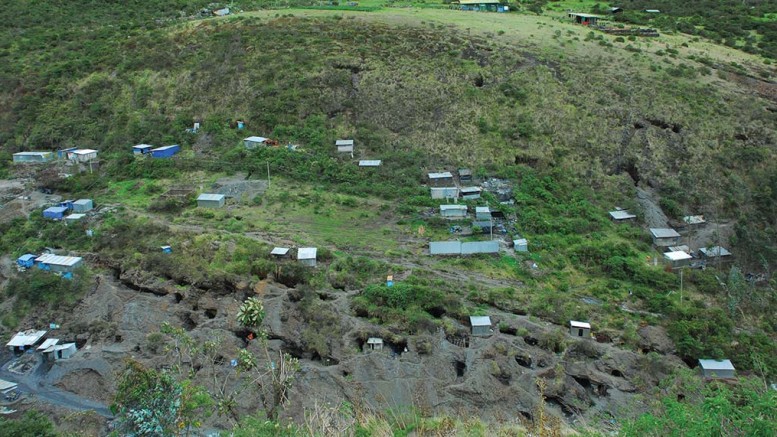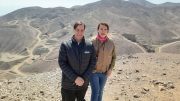OLLACHEA, PUNO PROVINCE, PERU — Women sift through slate muck piles, raking through the debris with a fork in one hand and a water hose in the other, looking for the distinctive ghostly appearance of quartz veins in a final attempt to find gold from the artisanal workings at Ollachea.
Gold has been mined from this southeastern corner of Peru — a few hours’ drive north from Lake Titicaca — since Spanish colonial times. A ruined mill sits on the hill overlooking the valley, and the river bank is pockmarked with dark holes where the local miners have been.
Today’s artisanal miners have only a short time left to work in the zone. The national government has already evicted everyone outside of the Ollachea community, and it plans to shut down the rest of the artisanals on the grounds that they work too close to the Ollachea River.

A photo from 2010 of the Minapampa section of Minera IRL’s Ollachea gold project in Peru. Credit: Minera IRL.
But the locals have hope for a more prosperous economic future in the form of Lima-based Minera IRL (LIMA: BVL) and its nearby Ollachea project, a mid-scale gold project on the cusp of development.
Ollachea is fully permitted, has a landmark 30-year social licence agreement with the local community and a 1.2 km exploration tunnel developed above the main orebody, which can serve as the main access to the orebody.

An artisanal miner above the town of Ollachea, Peru, in 2011. Photo by John Cumming.
Mineral IRL also has a US$240-million credit line with state development agency Cofide — in part because of the jobs the project will create for former artisanal miners in the area.
The company recently signed an engineering, procurement and construction contract with Peruvian engineering firm GyM to build the mine.
Minera IRL spent over a year working with the community, which resulted in the 30-year social licence agreement, in large part due to the efforts of country manager Diego Benavides (who became Minera IRL’s CEO on Dec. 5) and corporate social responsibility manager Magaly Villena.
Under the agreement, the Ollachea community has a 5% carried interest in the project — an innovative, yet perhaps obvious way to align the interests of the community with those of the company. It also helps overcome the locals’ historical resistance and suspicion of formal miners, during which time Rio Tinto (NYSE: RIO), the former concession owner, could never really get on the ground to do work.
Minera IRL is working with Mining Plus to optimize a feasibility study to lower initial capital costs while keeping the envisioned 100,000 oz. gold per year production profile. By targeting higher-grade areas early on, the first optimization study increased net present value 17%, and lowered anticipated payback from 3.7 to 3.1 years.
Since July, Mining Plus has looked at more optimization, but now without a 3,000-tonne-per-day required rate from the start of production.

The exploration drive at Minera IRL’s Ollachea gold project in Peru. Credit: Minera IRL.
Longhole open-stoping with tailings and waste-rock backfill is still the preferred mining method for what would be a fully mechanized mine, with cut and fill in narrower sections. Minera IRL calculates that 96% of the ore can be recovered this way.
At the same time AMEC is working on a revised flow sheet for the mine’s processing plant, all with a view to break ground for full mine development by mid-2017.
Minera IRL has already decided to relocate a tailings plant near the western mine portal.
Other optimizations under consideration include: staging the development of the ventilation system and perhaps lowering its diameter; contract mining during the first three years of operation; using on-highway, 32-tonne trucks rather than mining trucks; and lowering the amount of cable bolting in the mine.
The 1.2 km exploration tunnel incline has allowed Minera IRL to complete a 5,200-metre drilling campaign along strike to delineate more resources (assays to be released soon), obtain material for more metallurgical test work and prepare a 4.5-by-4-metre tunnel over the orebody before mine development.
The mine would also feature a decline from the other side of the mountain to access the western part of the orebody. The tight geography of the narrow valley means that the processing plant would be a stone’s throw away from the eastern portal, and a tailings storage facility is permitted a few hundred metres down a paved road.
The company has yet to decide whether the dry-stacked tailings would be trucked to site, or piped over a ridge to the site. The pipeline or conveyor area has been declared an archeological site that the company cannot use until after full investigation.

Map of Minera IRL’s Ollachea gold deposit in Peru’s Puna province. Credit: Minera IRL.
Gold mineralization at Ollachea is hosted in a shear zone in quartz veinlets in slate — in particular veinlets that have folded or otherwise are heavily deformed, often with visible gold present.
The main orebody is comprised of the Minapampa zone, which has two structures, defined via 61,000 metres of drilling in 156 holes. Another 16,900 metres of drilling in 47 holes was completed at the Concurayoc zone.
Ollachea has proven and probable reserves of 9.2 million tonnes grading 3.4 grams gold per tonne for 1 million oz. gold, plus measured and indicated resources of 10.1 million tonnes at 4 grams gold for 1.3 million oz. gold. Another 12.1 million inferred tonnes grade 3 grams gold for 1.1 million oz. gold.
There are also indications from regional exploration that this is only the beginning of defining the wider deposit, with Minapampa West, Concurayoc southwest and other zones being explored.
With the future seemingly looking bright, what is holding up the project?
If every silver lining has a cloud, Minera IRL is still reeling from the death of its founder Courtney Chamberlain in April 2015, and the subsequent reign of former executive chairman Daryl Hodges and related corporate infighting. Hodges was booted from the company in August 2015 after the community withdrew its support for the project, and an internecine battle took place between the Hodges camp, and another led by Benavides.
Minera IRL’s interim CEO at the time of the site visit in November 2016, Frank O’Kelly, spent much of the past year trying to patch up the fractured company. Under his tenure, Minera IRL regained control over its Peruvian subsidiaries in May and management consultants EY were brought in. O’Kelly was removed as a interim CEO and a director in a shareholder vote on Nov. 30, 2016. Recently appointed director Robert Schafer did not run for re-election, among other corporate changes.
“Corporate governance has been tightened and a code of ethics implemented,” O’Kelly said. “I have made considerable progress to move the company forward physically, including the resumption of activities at Ollachea and prolonged mining activity at our Corihuarmi mine in Peru. Politically I have kept Cofide on track despite considerable attacks by the former administration. I am also building a strong management team to administer the upcoming Ollachea development.”
During the site visit some Peruvian shareholders did not see things this way and looked to throw out most of the board of directors at the upcoming meeting. They argued the newly constituted board was trying to usurp the company and sell it below market value, or take a position in the company before its share price can recover.
O’Kelly, who stepped in after Hodges left, said the board’s intentions had been misunderstood, and perhaps not well communicated.
— Based in Medellin, Colombia, Paul Harris is editor and publisher of Colombia Gold Letter and organizer of the annual Colombia Gold Symposium in Medellin. Visit colombiagold.co or email paul.corresponsal@gmail.com for more information.





Be the first to comment on "Site visit: Minera IRL’s Ollachea shows potential despite boardroom battles"